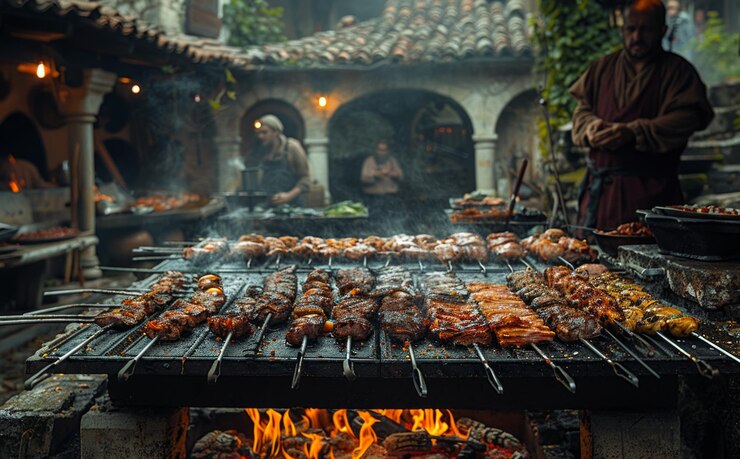Introduction
Have you ever experienced the rich, smoky flavor of meat cooked on a Santa Maria grill? If not, you’re in for a treat! This grilling tradition from California’s Central Coast is renowned for its simplicity and extraordinary taste. Let’s dive into the world of Santa Maria grilling and discover what makes it so special.
History of Santa Maria Grill
The Santa Maria grill has deep roots in the culinary traditions of Santa Maria, California. Dating back to the mid-19th century, this method was born out of community barbecues hosted by local ranchers. These events featured large cuts of beef cooked over an open flame, seasoned simply with salt, pepper, and garlic salt. Over the years, the technique evolved, but the essence of communal, flavorful grilling remains unchanged.
What Makes Santa Maria Grill Unique
So, what sets Santa Maria grilling apart from other styles? First and foremost, it’s the grill itself. A Santa Maria grill is characterized by its open design and adjustable grate, which allows for precise control over the cooking temperature. Unlike traditional grills, this setup ensures that the meat is cooked evenly and infused with a smoky flavor that’s hard to beat.
Essential Equipment for Santa Maria Grill
To get started with Santa Maria grilling, you’ll need a few key pieces of equipment. The centerpiece is the Santa Maria-style grill, typically featuring an adjustable grate that can be raised or lowered over the coals. Additionally, you’ll need a good set of tongs, a meat thermometer, and a basting brush. These tools will help you manage the grill and ensure your meat is cooked to perfection.
Choosing the Right Wood
The type of wood you use is crucial to achieving the authentic Santa Maria flavor. Traditionally, red oak is the wood of choice, imparting a distinctive, slightly sweet smoke flavor to the meat. If red oak isn’t available, other hardwoods like hickory or oak can be used as substitutes. The key is to avoid softwoods, which can produce a bitter taste and excessive smoke.
Selecting the Best Meat
Santa Maria grilling is all about quality meat. The star of the show is typically beef tri-tip, a flavorful and tender cut that stands up well to the intense heat of the grill. Other popular choices include sirloin, ribeye, and even chicken or pork. When selecting your meat, look for cuts with good marbling and a fresh, bright color. This ensures a juicy, flavorful result.
The Santa Maria Marinade
A hallmark of Santa Maria grilling is the marinade. While the meat is often seasoned simply with salt, pepper, and garlic salt, a marinade can add an extra layer of flavor. A classic Santa Maria marinade includes ingredients like olive oil, red wine vinegar, garlic, and herbs. To prepare, combine the ingredients and let the meat soak in the mixture for at least a few hours, preferably overnight.
Prepping the Grill
Proper grill setup is essential for successful Santa Maria grilling. Start by building a hot bed of coals using your chosen wood. Allow the coals to burn down until they’re covered with a layer of white ash. This indicates they’re ready for grilling. Adjust the grate height to control the temperature, aiming for a medium-high heat.
Grilling Techniques
Mastering Santa Maria grilling requires some skill, but with a few tips, you’ll be a pro in no time. The key is to control the heat by adjusting the grill grate. Start with the grate higher for a gentler heat and lower it as needed to achieve a nice sear. Turn the meat frequently to ensure even cooking and baste with a mixture of olive oil and marinade to keep it moist.
Cooking Times and Temperature
Cooking times will vary depending on the cut and thickness of the meat. For tri-tip, aim for an internal temperature of 130°F for medium-rare. Use a meat thermometer to check the temperature and avoid overcooking. Remember, the meat will continue to cook slightly after it’s removed from the grill, so it’s better to err on the side of undercooking.
Side Dishes to Complement Santa Maria Grill
No Santa Maria barbecue is complete without the right side dishes. Traditional sides include pinquito beans, a small, pink bean native to the Santa Maria Valley, and a fresh, tangy salsa. Other great accompaniments are garlic bread, green salad, and grilled vegetables. These sides balance the rich flavors of the grilled meat and add variety to your meal.
Serving and Presentation
When it comes to serving Santa Maria grilled meat, simplicity is key. Slice the meat against the grain to ensure tenderness and arrange it on a platter. Garnish with fresh herbs or a sprinkle of sea salt for a touch of elegance. Serve with your chosen sides and enjoy the feast!
Health Benefits of Grilling
Grilling isn’t just about great flavor; it’s also a healthy cooking method. Grilled meats tend to have lower fat content since excess fat drips off during cooking. Additionally, the high heat helps to preserve nutrients, making grilled vegetables especially nutritious. Compared to frying or baking, grilling can be a healthier option for enjoying your favorite foods.
Common Mistakes to Avoid
Even seasoned grill masters can make mistakes. One common error is using too much marinade, which can cause flare-ups and burnt meat. Another is not letting the meat rest after cooking, which can result in dry, tough meat. To avoid these pitfalls, use marinade sparingly and let the meat rest for at least 10 minutes before slicing.
Conclusion
Santa Maria grilling is more than just a cooking method; it’s a culinary tradition that brings people together. With its simple, yet flavorful approach, it’s easy to see why this style of grilling has stood the test of time. Whether you’re a grilling novice or a seasoned pro, there’s always something new to discover with Santa Maria grill. So fire up your grill, gather your friends and family, and enjoy a delicious meal that’s sure to impress.
FAQs
What is the best wood for Santa Maria grill?
Red oak is traditionally used for Santa Maria grilling due to its sweet, smoky flavor. If unavailable, other hardwoods like hickory or oak can be good substitutes.
How do I maintain the right temperature?
Use the adjustable grate on a Santa Maria grill to control the heat. Start with the grate higher for lower heat and lower it as needed for more intense heat. A meat thermometer can also help ensure the meat reaches the desired temperature.
Can I use a Santa Maria grill for other foods?
Absolutely! While it’s famous for beef tri-tip, a Santa Maria grill can be used to cook a variety of meats, vegetables, and even fruits for a smoky, flavorful twist.
What sides go best with Santa Maria grilled meats?
Traditional sides include pinquito beans, salsa, garlic bread, and green salad. Grilled vegetables also make a great accompaniment, adding color and nutrition to your meal.
How do I know when the meat is done?
Use a meat thermometer to check the internal temperature. For medium-rare tri-tip, aim for 130°F. Remember that the meat will continue to cook slightly after being removed from the grill, so take it off a few degrees early.







